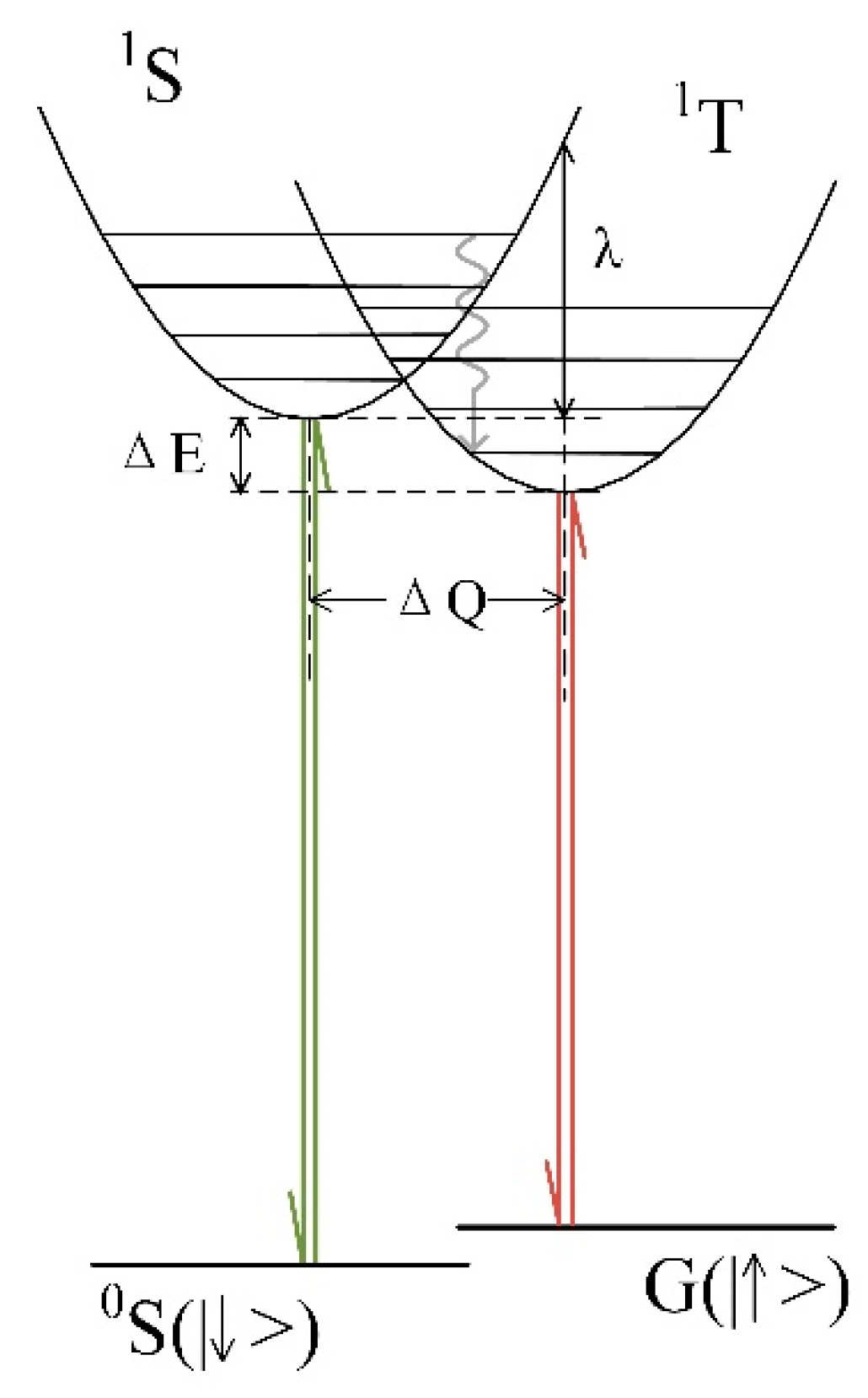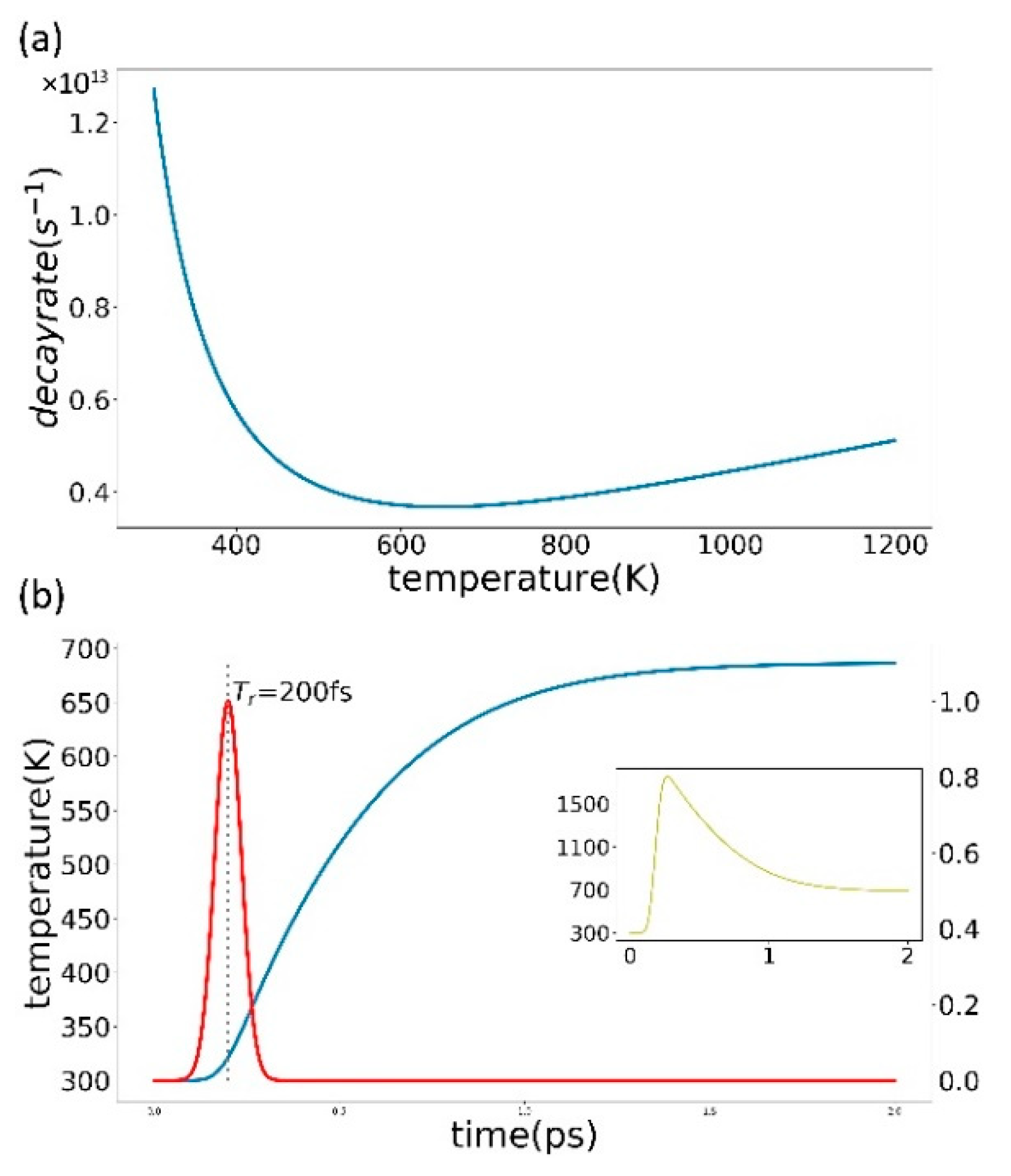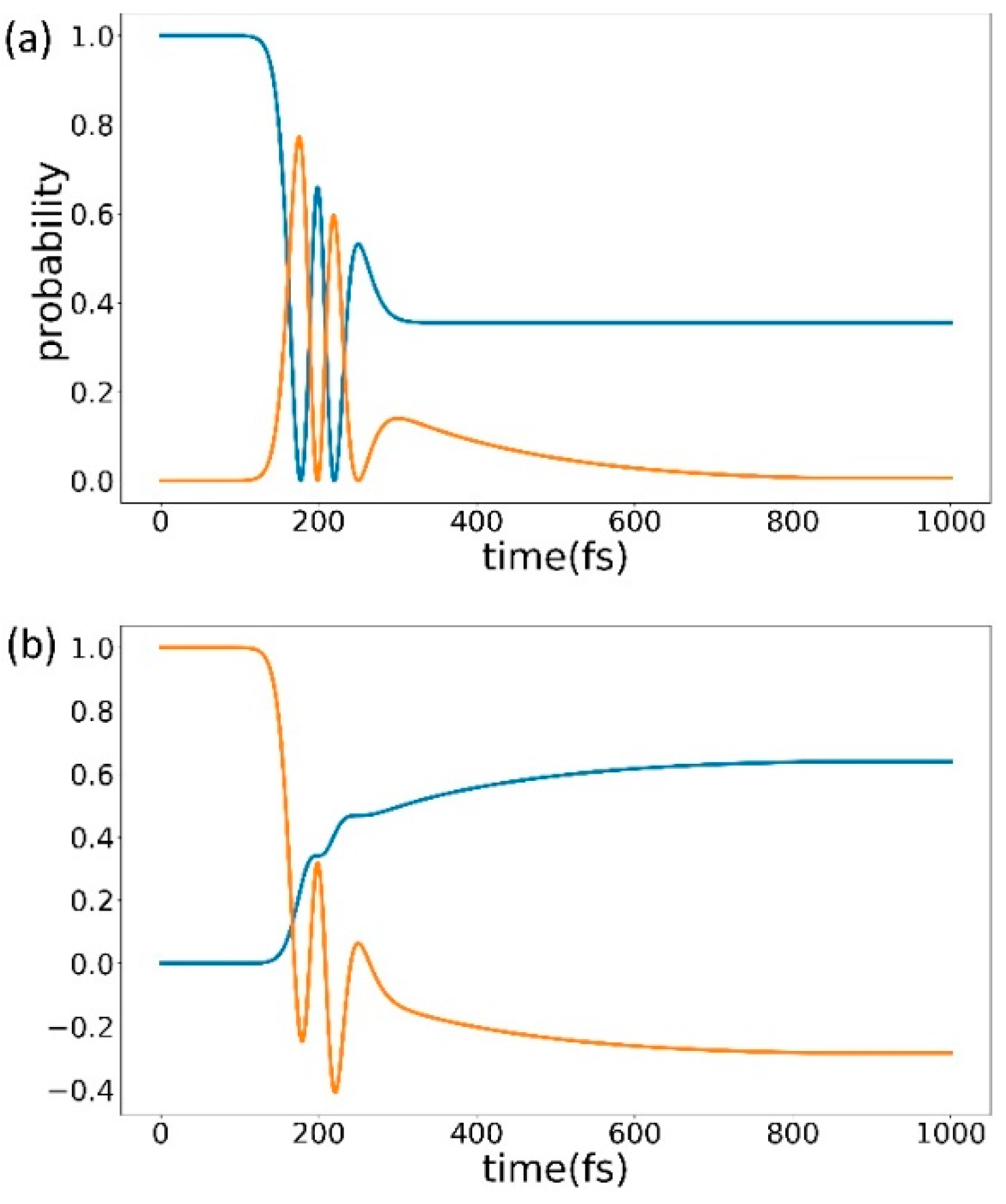Theoretical Investigation of All Optical Switching by Intersystem Crossing
Abstract
:1. Introduction
2. Dynamic Description of Electron in Laser Field
3. Discussion and Results
4. Conclusions
Author Contributions
Funding
Conflicts of Interest
References
- Kimel, A.V.; Kirilyuk, A.; Rasing, T. Femtosecond opto-magnetism: Ultrafast laser manipulation of magnetic materials. Laser Photonics Rev. 2007, 1, 275–287. [Google Scholar] [CrossRef]
- Kirilyuk, A.; Kimel, A.V.; Rasing, T. Laser-induced magnetization dynamics and reversal in ferrimagnetic alloys. Rep. Prog. Phys. 2013, 76, 026501. [Google Scholar] [CrossRef] [PubMed]
- Vahaplar, K.; Kalashnikova, A.M.; Kimel, A.V.; Hinzke, D.; Nowak, U.; Chantrell, R.; Rasing, T. Ultrafast path for optical magnetization reversal via a strongly. Phys. Rev. Lett. 2009, 103, 117201. [Google Scholar] [CrossRef] [PubMed] [Green Version]
- Alebrand, S.; Hassdenteufel, A.; Steil, D.; Cinchetti, M.; Aeschlimann, M. Interplay of heating and helicity in all-optical magnetization switching. Phys. Rev. B 2012, 85, 092401. [Google Scholar] [CrossRef]
- Khorsand, A.R.; Savoini, M.; Kirilyuk, A.; Kimel, A.V.; Tsukamoto, A.; Itoh, A.; Rasing, T. Role of magnetic circular dichroism in all-optical magnetic recording. Phys. Rev. Lett. 2012, 108, 127205. [Google Scholar] [CrossRef]
- Steil, D.; Alebrand, S.; Hassdenteufel, A.; Cinchetti, M.; Aeschlimann, M. All-optical magnetization recording by tailoring optical excitation parameters. Phys. Rev. B 2011, 84, 224408. [Google Scholar] [CrossRef]
- Lambert, C.H.; Mangin, S.; Varaprasad, B.C.S.; Takahashi, Y.K.; Hehn, M.; Cinchetti, M.; Fullerton, E.E. All-optical control of ferromagnetic thin films and nanostructures. Science 2014, 345, 1337. [Google Scholar] [CrossRef] [Green Version]
- Cornelissen, T.D.; Córdoba, R.; Koopmans, B. Microscopic model for all optical switching in ferromagnets. Phys. Rev. Lett. 2016, 108, 142405. [Google Scholar] [CrossRef] [Green Version]
- Vomir, M.; Albrecht, M.; Bigot, J.Y. Single shot all optical switching of intrinsic micron size magnetic domains of a Pt/Co/Pt ferromagnetic stack. Phys. Rev. Lett. 2017, 111, 242404. [Google Scholar] [CrossRef]
- Parlak, U.; Adam, R.; Bürgler, D.E.; Gang, S.; Schneider, C.M. Optically induced magnetization reversal in [Co/Pt] N multilayers: Role of domain wall dynamics. Phys. Rev. B 2018, 98, 214443. [Google Scholar] [CrossRef]
- Ellis, M.O.; Fullerton, E.E.; Chantrell, R.W. All-optical switching in granular ferromagnets caused by magnetic circular dichroism. Sci. Rep. 2016, 6, 30522. [Google Scholar] [CrossRef] [PubMed]
- Kirilyuk, A.; Kimel, A.V.; Rasing, T. Ultrafast optical manipulation of magnetic order. Rev. Mod. Phys. 2010, 82, 2731. [Google Scholar] [CrossRef]
- Stanciu, C.D.; Hansteen, F.; Kimel, A.V.; Tsukamoto, A.; Itoh, A.; Kirilyuk, A.; Rasing, T. Ultrafast interaction of the angular momentum of photons with spins in the metallic amorphous alloy GdFeCo. Phys. Rev. Lett. 2007, 98, 207401. [Google Scholar] [CrossRef] [PubMed] [Green Version]
- Radu, I.; Vahaplar, K.; Stamm, C.; Kachel, T.; Pontius, N.; Dürr, H.A.; Tsukamoto, A. Transient ferromagnetic-like state mediating ultrafast reversal of antiferromagnetically coupled spins. Nature 2011, 472, 205. [Google Scholar] [CrossRef]
- Ostler, T.A.; Barker, J.; Evans, R.F.L.; Chantrell, R.W.; Atxitia, U.; Chubykalo-Fesenko, O.; Nolting, F. Ultrafast heating as a sufficient stimulus for magnetization reversal in a ferrimagnet. Nat. Commun. 2012, 3, 666. [Google Scholar] [CrossRef]
- Van der Ziel, J.P.; Pershan, P.S.; Malmstrom, L.D. Optically-induced magnetization resulting from the inverse Faraday effect. Phys. Rev. Lett. 1965, 15, 190. [Google Scholar] [CrossRef]
- Pershan, P.S.; Van der Ziel, J.P.; Malmstrom, L.D. Theoretical discussion of the inverse Faraday effect, Raman scattering, and related phenomena. Phys. Rev. 1966, 143, 574. [Google Scholar] [CrossRef]
- Popova, D.; Bringer, A.; Blügel, S. Theory of the inverse Faraday effect in view of ultrafast magnetization experiments. Phys. Rev. B 2011, 84, 214421. [Google Scholar] [CrossRef] [Green Version]
- Popova, D.; Bringer, A.; Blügel, S. Theoretical investigation of the inverse Faraday effect via a stimulated Raman scattering process. Phys. Rev. B 2012, 85, 094419. [Google Scholar] [CrossRef] [Green Version]
- Zhang, G.P.; Bai, Y.H.; George, T.F. Switching ferromagnetic spins by an ultrafast laser pulse: Emergence of giant optical spin-orbit torque. EPL Europhys. Lett. 2016, 115, 57003. [Google Scholar] [CrossRef] [Green Version]
- Zhang, G.P.; Babyak, Z.; Xue, Y.; Bai, Y.H.; George, T.F. First-principles and model simulation of all-optical spin reversal. Phys. Rev. B 2017, 96, 134407. [Google Scholar] [CrossRef] [Green Version]
- Murakami, M.; Babyak, Z.; Giocolo, M.; Zhang, G.P. Quantum mechanical interpretation of the ultrafast all optical spin switching. J. Phys. Condens. Matter 2017, 29, 184002. [Google Scholar] [CrossRef] [PubMed]
- Zhang, G.P.; Murakami, M.; Si, M.S.; Bai, Y.H.; George, T.F. Understanding all-optical spin switching: Comparison between experiment and theory. Mod. Phys. Lett. B 2018, 32, 1830003. [Google Scholar] [CrossRef]
- Ren, Y.; Lai, W.; Cevher, Z.; Gong, Y.; Zhang, G.P. Experimental demonstration of 55-fs spin canting in photoexcited iron nanoarrays. Appl. Phys. Lett. 2017, 110, 082404. [Google Scholar] [CrossRef]
- Zhang, G.P. Laser-induced orbital and spin excitations in ferromagnets: Insights from a two-level system. Phys. Rev. Lett. 2008, 101, 187203. [Google Scholar] [CrossRef]
- Zhang, G.P.; Hübner, W. Laser-induced ultrafast demagnetization in ferromagnetic metals. Phys. Rev. Lett. 2000, 85, 3025. [Google Scholar] [CrossRef] [PubMed]
- Hennecke, M.; Radu, I.; Abrudan, R.; Kachel, T.; Holldack, K.; Mitzner, R.; Eisebitt, S. Angular Momentum Flow During Ultrafast Demagnetization of a Ferrimagnet. Phys. Rev. Lett. 2019, 122, 157202. [Google Scholar] [CrossRef]
- Bergeard, N.; López-Flores, V.; Halte, V.; Hehn, M.; Stamm, C.; Pontius, N.; Boeglin, C. Ultrafast angular momentum transfer in multisublattice ferrimagnets. Nat. Commun. 2014, 5, 3466. [Google Scholar] [CrossRef] [Green Version]
- Dornes, C.; Acremann, Y.; Savoini, M.; Kubli, M.; Neugebauer, M.J.; Abreu, E.; Bothschafter, E.M. The ultrafast Einstein—De Haas effect. Nature 2019, 565, 209. [Google Scholar] [CrossRef]
- Beaud, P.; Caviezel, A.; Mariager, S.O.; Rettig, L.; Ingold, G.; Dornes, C.; Kubacka, T. A time-dependent order parameter for ultrafast photoinduced phase transitions. Nat. Mater. 2014, 13, 923. [Google Scholar] [CrossRef]
- Penfold, T.J.; Gindensperger, E.; Daniel, C.; Marian, C.M. Spin-vibronic mechanism for intersystem crossing. Chem. Rev. 2018, 118, 6975. [Google Scholar] [CrossRef] [PubMed] [Green Version]
- Chang, J.; Fedro, A.J.; Van Veenendaal, M. Ultrafast cascading theory of intersystem crossings in transition-metal complexes. Phys. Rev. B 2010, 82, 075124. [Google Scholar] [CrossRef] [Green Version]
- Bressler, C.; Milne, C.; Pham, V.T.; ElNahhas, A.; van der Veen, R.M.; Gawelda, W.; Borca, C.N. Femtosecond XANES study of the light-induced spin crossover dynamics in an iron (II) complex. Science 2009, 323, 489–492. [Google Scholar] [CrossRef] [PubMed]
- Shore, B.W. Manipulating Quantum Structures Using Laser Pulses; Cambridge University Press: Cambridge, UK, 2011. [Google Scholar]
- Batista, A.A. Rabi oscillations in two-level systems beyond the rotating-wave approximation. arXiv 2015, arXiv:1507.05124. [Google Scholar]
- El-Sayed, M.A. Spin—Orbit coupling and the radiationless processes in nitrogen heterocyclics. J. Chem. Phys. 1963, 38, 2834. [Google Scholar] [CrossRef]
- Peng, Q.; Niu, Y.; Shi, Q.; Gao, X.; Shuai, Z. Correlation function formalism for triplet excited state decay: Combined spin–orbit and nonadiabatic couplings. J. Chem. Theory Comput. 2013, 9, 1132–1143. [Google Scholar] [CrossRef]
- Englman, R.; Jortner, J. The energy gap law for radiationless transitions in large molecules. Mol. Phys. 1970, 18, 145–164. [Google Scholar] [CrossRef]
- Marcus, R.A.; Sutin, N. Biochimica et Biophysica Acta (BBA)—Reviews on Bioenergetics. Biochim. Biophys. Acta 1985, 811, 265–322. [Google Scholar] [CrossRef]
- Jortner, J. Temperature dependent activation energy for electron transfer between biological molecules. J. Chem. Phys. 1976, 64, 4860–4867. [Google Scholar] [CrossRef]
- de Jong, M.; Seijo, L.; Meijerink, A.; Rabouw, F.T. Resolving the ambiguity in the relation between Stokes shift and Huang–Rhys parameter. Phys. Chem. Chem. Phys. 2015, 17, 16959. [Google Scholar] [CrossRef] [Green Version]
- Van Veenendaal, M.; Chang, J.; Fedro, A.J. Model of ultrafast intersystem crossing in photoexcited transition-metal organic compounds. Phys. Rev. Lett. 2010, 104, 067401. [Google Scholar] [CrossRef] [PubMed] [Green Version]
- Mendil, J.; Nieves, P.; Chubykalo-Fesenko, O.; Walowski, J.; Santos, T.; Pisana, S.; Münzenberg, M. Resolving the role of femtosecond heated electrons in ultrafast spin dynamics. Sci. Rep. 2014, 4, 3980. [Google Scholar] [CrossRef] [PubMed] [Green Version]
- Savoini, M.; Medapalli, R.; Koene, B.; Khorsand, A.R.; Le Guyader, L.B.P.J.; Duo, L.; Kirilyuk, A. Highly efficient all-optical switching of magnetization in GdFeCo microstructures by interference-enhanced absorption of light. Phys. Rev. B 2012, 86, 140404. [Google Scholar] [CrossRef] [Green Version]
- Gorchon, J.; Wilson, R.B.; Yang, Y.; Pattabi, A.; Chen, J.Y.; He, L.; Bokor, J. Role of electron and phonon temperatures in the helicity-independent all-optical switching of GdFeCo. Phys. Rev. B 2016, 94, 184406. [Google Scholar] [CrossRef] [Green Version]




© 2019 by the authors. Licensee MDPI, Basel, Switzerland. This article is an open access article distributed under the terms and conditions of the Creative Commons Attribution (CC BY) license (http://creativecommons.org/licenses/by/4.0/).
Share and Cite
Zou, Y.; Wang, H.; Huang, H.; Zeng, Z.; Wang, K.; Wang, S.; Li, X.; Xie, C. Theoretical Investigation of All Optical Switching by Intersystem Crossing. Appl. Sci. 2020, 10, 128. https://doi.org/10.3390/app10010128
Zou Y, Wang H, Huang H, Zeng Z, Wang K, Wang S, Li X, Xie C. Theoretical Investigation of All Optical Switching by Intersystem Crossing. Applied Sciences. 2020; 10(1):128. https://doi.org/10.3390/app10010128
Chicago/Turabian StyleZou, Yuhao, Haiwei Wang, Haozhe Huang, Zhihao Zeng, Kai Wang, Sicong Wang, Xiangping Li, and Changsheng Xie. 2020. "Theoretical Investigation of All Optical Switching by Intersystem Crossing" Applied Sciences 10, no. 1: 128. https://doi.org/10.3390/app10010128




